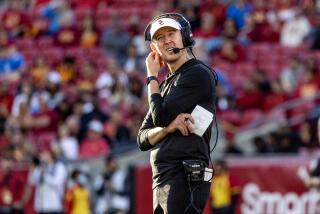Riley and Kareem Go Way Back
- Share via
SCHENECTADY, N.Y. — Before there was Pat Riley, the most successful NBA coach of the decade, there was Pat Riley, high-scoring basketball star for Linton High School in Schenectady.
And before there was Kareem Abdul-Jabbar, the most prolific scorer and rebounder in NBA history, there was Lew Alcindor, gangly center from Power Memorial in New York City.
The two men whose highly successful player-coach relationship with the Lakers will end in the next few weeks were hot-shot school-boy basketball players the first time their paths crossed in the finals of a scholastic tournament on Dec. 29, 1961.
When people around here remember that bitterly cold night, the Riley and Jabbar they see aren’t the ones familiar to basketball fans today.
Riley was yet to acquire his Hollywood good looks and tailoring. He wore a crew cut and his teammates remember him as the unquestioned star of a very good high school team--every player on the roster eventually went to college on an athletic scholarship--who loved to run the floor and score on fast breaks.
Alcindor wasn’t even a star in 1961, just a skinny 6-foot-10 14-year-old freshman who was all arms and legs and tremendous potential. Opponents recall that Alcindor had only an embryonic version of his skyhook at the time and that it was easy to muscle his slight frame away from the basket.
“An awkward kid, that’s what we thought, if you must know,” said Cartlon Newton Sr., whose son played for Linton. “Jabbar was tall, that’s about all you can say for him.”
But to others, Alcindor’s talents were obvious. Marv Cermak, covering the eight-team Christmas tournament for the Schenectady Gazette, predicted that college recruiters would soon be beating a path to Alcindor’s door.
And Linton players on the court said it was obvious that Alcindor had more than just height going for him.
Bill Boehm, the Linton center who’d be the decisive player in the game, called Alcindor “a gawky kid.”
“But there was one play, down around the south end of the Linton high gym,” he recalled. “There was a loose ball and I reached down for it with some other players. By the time I could turn around he (Alcindor) had picked it up and dunked it. . . . You could tell that he was going to be the next big player in the game.”
Still, at that time, you’d have found as many people willing to bet that Riley’s playing career would be as bright as Alcindor’s. Today, his former teammates use such words as “aggressive” and “hard-nosed” to describe the playing style of a teen-ager nicknamed the “Linton flash.”
Riley would eventually star for Adolph Rupp at Kentucky and play in the NBA with the Lakers and the Suns.
The 6-3 junior forward was so good in high school, in fact, that Linton Coach Walter Przybylo expected him to take most of his team’s shots, especially at the end of close games.
The tactic almost invariably worked. With the help of another outstanding athlete who played at Linton in the late 1950s, future NBA player Barry Kramer, the school won 52 of 54 games in one stretch from 1958 to 1961.
According to point guard Robert DeLuca, Linton was hardly fazed by playing a “name” team such as Power Memorial, though he said one Power player in particular--guard John Hayes--caused great concern.
“He was a left-handed guard,” said DeLuca, who would tie Riley for Linton scoring honors with 19 points against Power Memorial. “He was very quick, an excellent shooter. Just an outstanding player. We were far more worried about Hayes than we were about Alcindor and we never really did stop him.”
In the end, Linton’s concern was properly placed: Hayes had 29 points while Alcindor managed only eight.
Power Memorial opened up a 43-35 lead at halftime, but Linton scored the first eight points of the second half and led most of the rest of the way in a 74-68 victory before more than 2,000 spectators.
Cermak figured it was Boehm who made the difference for Linton. The 6-5 junior center came into the game as the “most impotent scorer” in Linton’s starting lineup, according to the reporter, but he scored 10 “important markers” against Power Memorial.
Boehm said Przybylo’s unwritten rule about setting up shots for Riley whenever possible led to his performance in a game that’s now notable only because of the presence of Riley and Jabbar.
“In the previous game in that tournament I took a shot from the baseline and Przybylo immediately pulled me aside and in front of 2,000 people said, ‘Never go in that corner, that’s Riley’s corner,’ ” Boehm said. “I was in there to get the rebound and throw the ball out, not shoot it. We were basically supposed to feed the ball to Riley. Well, I was up for that game with Alcindor and when I got the ball in that corner I shot it. . . . It was a hell of a game.”
More to Read
All things Lakers, all the time.
Get all the Lakers news you need in Dan Woike's weekly newsletter.
You may occasionally receive promotional content from the Los Angeles Times.







